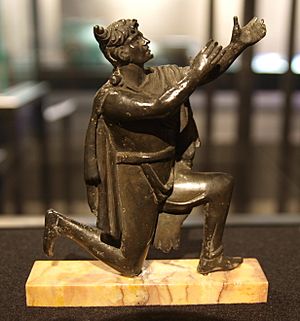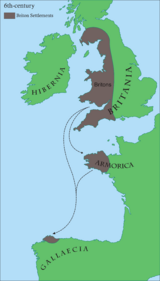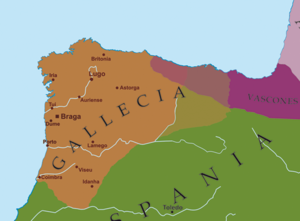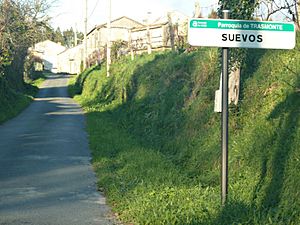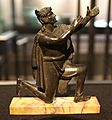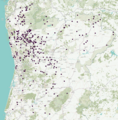Kingdom of the Suebi facts for kids
Quick facts for kids
Kingdom of the Suebi
Regnum Suevorum (Latin)
|
|||||||||
|---|---|---|---|---|---|---|---|---|---|
| 409–585 | |||||||||
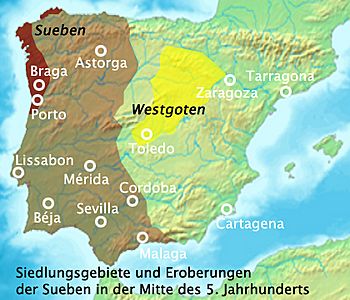
Greatest extent of the Suebian Kingdom c. 455 AD
|
|||||||||
| Capital | Braga | ||||||||
| Common languages | Suebi (spoken among elite) Latin (administrative/liturgical) |
||||||||
| Religion | Germanic paganism (initially among elite and rural) Arianism (mostly among elite) Chalcedonian Christianity (among commoners) |
||||||||
| Government | Monarchy | ||||||||
| King | |||||||||
|
• 409–438
|
Hermeric | ||||||||
|
• 585
|
Malaric | ||||||||
| History | |||||||||
| 409 | |||||||||
|
• Conquest by the King Leovigild of the Visigothic Kingdom
|
585 | ||||||||
|
|||||||||
| Today part of | Gibraltar Spain Portugal |
||||||||
The Kingdom of the Suebi (Latin: Regnum Suevorum) was an early kingdom formed by a Germanic people called the Suebi. It was one of the first kingdoms to break away from the Roman Empire. This kingdom was located in what is now Portugal and Spain, mainly in the areas of Gallaecia and northern Lusitania.
The Suebi established their kingdom around 409 AD. By the 6th century, it was officially known as the Kingdom of Gallaecia. The Suebi kept their independence until 585 AD. At that time, the Visigoths conquered them. The Suebi kingdom then became a part of the Visigothic Kingdom in Hispania (the Iberian Peninsula).
Contents
The Suebi: Who Were They?
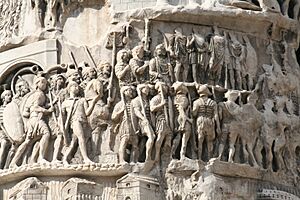
Not much is known about the Suebi before they entered the Roman Empire. They crossed the Rhine river on December 31, 406 AD. Some historians think they might have been the same group as the Quadi. The Quadi lived north of the Danube river. They fought against the Romans in the 2nd century.
Other historians say the Suebi were a new group. They might have formed from smaller tribes, including parts of the Quadi. These groups came together during their long journey from the Danube valley.
Many Germanic peoples moved west in the late 4th century. One idea is that the Huns pushed them from the east. This forced groups like the Suebi to move into Roman lands.
Settling in the Iberian Peninsula
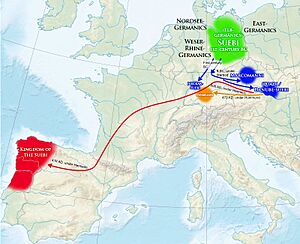
The Suebi, along with the Vandals and Alans, entered the Roman Empire in 405 AD. The Roman Empire was weak at this time. It was dealing with many invasions and civil wars. This allowed the invaders to move into Gaul (modern France) with little trouble.
In 409 AD, the Suebi, Vandals, and Alans moved south into Hispania. A civil war in Hispania left the mountain passes open. The invaders plundered cities and farms, causing a famine.
In 411 AD, these groups divided the land among themselves. The Suebi and the Hasding Vandals shared the northwestern province of Gallaecia. The Suebi settled in the western part of Gallaecia. This area is now between the cities of Porto in Portugal and Pontevedra in Spain.
Soon, Braga became their capital city. Their land grew to include Astorga and the Minho river valley. At first, the Suebi and the local people got along well. One historian said the newcomers "turned their swords into ploughs."
The Suebi spoke a Germanic language. Some other Germanic groups also settled with them. For example, the Buri settled in a region of Portugal. This area is still called Terras de Bouro (Lands of the Buri).
The Kingdom in the 5th Century
King Hermeric: The Founder
In 416 AD, the Visigoths came to Hispania. They were sent by the Roman emperor to fight the invaders. By 418 AD, the Visigoths had defeated the other groups. Only the Hasding Vandals and the Suebi remained.
In 419 AD, a fight broke out between the Vandals and the Suebi. The Suebi were led by their king, Hermeric. Roman forces stepped in and attacked the Vandals. This forced the Vandals to move to another part of Hispania. The Suebi were left in control of almost all of Gallaecia.
In 429 AD, the Vandals left Hispania for Africa. The Suebi became the only barbarian group left in the region. King Hermeric spent his reign making Suebi rule strong in Gallaecia. He made peace with the local people in 438 AD. This peace lasted for twenty years. After this, Hermeric became ill and retired.
King Rechila: Expanding the Kingdom
In 438 AD, Hermeric's son, Rechila, became king. Rechila wanted to expand the kingdom. He campaigned in other parts of the Iberian Peninsula. He defeated a Roman general and captured treasure.
In 439 AD, the Suebi invaded Lusitania and took its capital, Mérida. Mérida briefly became the new capital of the Suebi kingdom. In 441 AD, Rechila's armies conquered Seville. With Seville, the Suebi controlled large parts of southern Hispania. However, some historians say their control was mostly through raids.
In 446 AD, the Romans sent an army to fight the Suebi. Rechila defeated them, and the Roman general fled. No more Roman attempts were made to retake Hispania. Rechila died in 448 AD as a pagan. His son, Rechiar, became king.
King Rechiar: A Catholic King
Rechiar became king in 448 AD. He was a Catholic Christian. This was unusual, as most Germanic kings at the time were not Catholic. He was also the first Suebi king to mint coins with his own name. This showed the Suebi's independence.
Rechiar married the daughter of the Gothic king, Theodoric I. This helped improve relations between the two peoples. He also led raids into Roman-controlled areas. He captured prisoners and took them back to Gallaecia as servants.
In 455 AD, the Suebi plundered lands that had been returned to Rome. The Roman emperor and the Visigoths sent a joint message. They reminded Rechiar of the peace treaty. But Rechiar launched two more campaigns, taking many prisoners.
In response, the Visigothic king Theodoric II led a large army into Gallaecia in 456 AD. The Suebi and Goths met in battle near Astorga. The Goths defeated the Suebi. Many Suebi were killed or captured. King Rechiar fled but was later captured and executed in December. Theodoric continued fighting the Suebi for three months.
Competing Kings and Unity
After Rechiar's death, the royal family line ended. The Suebi had trouble choosing a new leader.
- In 456 AD, a Goth named Aioulf took over. He was killed in 457 AD.
- The Suebi then chose Maldras as king. This led to a split among the Suebi. Some followed another king named Framta, who died a year later.
- After Maldras was killed in 460 AD, Frumar succeeded him in the south. In the north, Rechimund became king. He captured the city of Lugo, which became an important Suebi center.
This period was marked by internal conflicts and fighting with the local people.
King Remismund: Uniting the Suebi
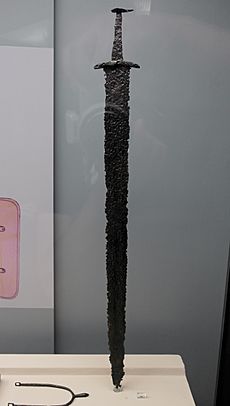
In 464 AD, Remismund became king. He was able to unite the different Suebi groups. He also brought peace to the kingdom. The Visigothic king Theodoric recognized Remismund. He even sent him gifts and a wife.
Under Remismund, the Suebi raided nearby lands again. They plundered Lusitania. In 468 AD, they destroyed parts of the walls of Conimbriga. The city was sacked, and many people were taken as slaves. The next year, they captured Lisbon.
The Suebi were mostly pagan at this time. However, an Arian missionary named Ajax converted them to Arianism in 466 AD. Arianism was a form of Christianity that differed from the main Catholic beliefs. This Arian church was strong among the Suebi until they converted to Catholicism in the 560s.
The Arian Period and Conversion to Catholicism
Not much is known about the Suebi kingdom between 470 and 550 AD. Historians say that many kings ruled during this time, and all of them were Arians.
Around 540 AD, a letter from Pope Vigilius mentioned that some Catholic churches had been destroyed. It also noted that some Catholics had converted to Arianism.
Becoming Catholic
The Suebi's conversion to Catholicism is told in different ways.
- One record from 561 AD states that King Ariamir ordered a church council. This council was the first Catholic one held in the kingdom.
- Another historian, Isidore of Seville, said that King Theodemar converted his people. He was helped by a missionary named Martin of Braga.
- A Frankish historian, Gregory of Tours, told a story about a king named Chararic. This king promised to become Catholic if his son was cured of leprosy. His son was healed, and Chararic converted. This story is often seen as a way to explain the work of Saint Martin of Braga.
Most historians believe the conversion happened gradually. Martin of Braga played a big role in leading the Suebi to Catholicism. He was a very educated man. He helped the kingdom grow culturally and politically.
The 6th Century and Annexation
Britons in Gallaecia
Around the late 5th or early 6th century, a group of Romano-Britons settled in the Suebi kingdom. They were escaping the Anglo-Saxons in Britain. Their new home became known as Britonia. Church records from 572 AD mention a "British church" and a "See of the Britons." This shows they had their own churches and a bishop.
King Ariamir and King Theodemar

On May 1, 561 AD, King Ariamir called the First Council of Braga. This council focused on condemning another Christian group called Priscillianism. It did not mention Arianism.
Later, on January 1, 569 AD, Ariamir's successor, King Theodemar, held a council in Lugo. This council organized the kingdom's administration and church. The Kingdom of Gallaecia was divided into two church provinces. These were under the leadership of the bishops of Braga and Lugo.
King Miro and the Visigoths
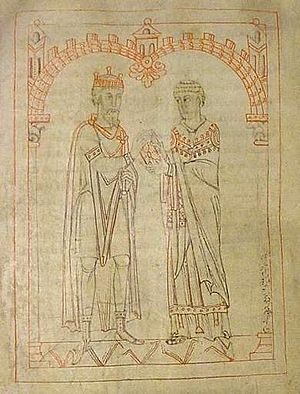
In 570 AD, Miro became king. During his reign, the Suebi kingdom faced challenges from the Visigoths. The Visigoths, led by King Leovigild, were rebuilding their own kingdom.
In 572 AD, Miro ordered the Second Council of Braga. Saint Martin of Braga led this council. He declared the Catholic faith to be the true faith in Gallaecia. He also spoke against Arianism.
From 573 AD, Leovigild's campaigns moved closer to Suebi lands. In 576 AD, he entered Gallaecia. Miro sent ambassadors and achieved a temporary peace.
In 579 AD, Leovigild's son, Hermenegild, rebelled against his father. Hermenegild had converted to Catholicism. He relied on support from the Eastern Roman Empire and the Suebi. In 583 AD, Miro marched south with his army to help Hermenegild. However, Leovigild surrounded Miro's army. Miro was forced to sign a treaty with the Visigothic king. Miro returned to Gallaecia and died soon after.
The Last Kings and Annexation
After Miro's death, his son Eburic became king. But his brother-in-law, Audeca, soon took power. Audeca forced Eburic into a monastery, making him unable to be king. Audeca then married Miro's widow and made himself king.
This gave King Leovigild a reason to invade. In 585 AD, Leovigild went to war against the Suebi. He invaded Gallaecia. A historian wrote that Leovigild "deprives Audeca of the totality of the Kingdom; the nation of the Sueves, their treasure and fatherland are conduced to his own power and turned into a province of the Goths." Audeca was captured and sent into exile.
In the same year, a man named Malaric tried to rebel against the Goths. But he was defeated and captured.
Becoming Part of the Visigothic Kingdom
After the conquest, King Leovigild brought back the Arian Church among the Suebi. But this did not last long. After Leovigild's death in 586 AD, his son Reccared encouraged everyone to convert to Catholicism.
The conversion happened during the Third Council of Toledo. Many bishops from Hispania and Gallaecia attended. Eight bishops gave up Arianism, including four Suebi bishops. King Reccared celebrated this conversion. He was called "King of the Visigoths and of the Suevi" by Pope Gregory the Great.
Under the Goths, the Suebi kingdom's administration was kept at first. But later, many of the Suebi districts disappeared. The last mention of the Suebi as a separate people was in a 10th-century text. By then, "Suebi" probably just meant "Gallaeci" (the people of Gallaecia).
List of Galician Suebic Monarchs
- Hermeric, c. 409–438
- Heremigarius, 427–429, leader in Lusitania
- Rechila, 438–448
- Rechiar, 448–456
- Aioulf, 456–457, a foreigner, possibly appointed by the Visigoths
- Maldras, 456–460, in opposition to Framta after 457
- Framta, 457, in opposition to Maldras
- Richimund, 457–464, successor of Framta
- Frumar, 460–464, successor of Maldras
- Remismund, 464–469, succeeded Frumar, reunited the Suebi
- Period of obscurity (little is known about this time)
- Hermeneric fl. c. 485
- Veremund fl. 535
- Theodemund fl. 6th century
- Chararic, after c.550–558/559, his existence is sometimes questioned
- Ariamir, 558/559–561/566
- Theodemar, 561/566–570
- Miro, 570–583
- Eboric, 583–584, removed from power and sent to a monastery by Andeca.
- Andeca, 584–585, removed from power and sent to a monastery by Leovigild.
- Malaric, 585, rebelled against Leovigild but was defeated.
Cultural Legacy of the Suebi
The Suebi quickly adopted the local Latin language. So, not many words from their Germanic language remained in Galician and Portuguese languages. It's hard to tell if some words came from the Suebi or the Goths. But there are some words, especially in Galicia and northern Portugal, that are thought to be from the Suebi. These words are often about farm life, animals, and the countryside.
Some examples include:
- laverca (lark)
- meixengra (titmouse, a type of bird)
- lobio (vinegrape)
- britar (to break)
- marco (boundary stone)
- bretema (mist)
- gabar (to praise)
The Suebi also left their mark on place names and personal names. Many personal names used by the Suebi were common in Galicia for a long time. From these names, many place names were created. For example:
- Sandiás comes from the name Sindila.
- Mondariz comes from Munderic.
- Gondomar comes from Gundemar.
- Baltar comes from Baltar.
- Guitiriz comes from Witteric.
Another group of place names that show old Germanic settlements are places called Sa, Saa, Sas in Galicia, or Sá in Portugal. These come from a Germanic word meaning 'house' or 'hall'.
In modern Galicia, there are still places named Suevos or Suegos. These names come from the Latin word Sueuos, meaning 'Sueves'. They point to old Suebi settlements.
Images for kids
-
Detail of the Column of Marcus Aurelius, built during this emperor's reign on the occasion of the triumph over, among other peoples, the Suevic tribes of Marcomanni and Quadi in the year 176. Piazza Colonna (Rome).
-
Suebic migrations across Europe ultimately spearheaded by Hermeric, founder and first ruler of the Kingdom of the Suebi in the northwest of the Iberian Peninsula (part of modern-day Portugal and Spain).
-
Suebic sword. Conimbriga, Portugal
-
Image of St Martin of Braga, (c.510 - 580). Codex Vigilanus or Albeldensis, Escurial library
-
King Ariamir with the bishops Lucrecio, Andrew, and Martin, during the first Council of Braga. Codex Vigilanus or Albeldensis, Escurial library
-
Miro, king of Gallaecia, and Saint Martin of Braga, from an 1145 manuscript of Martin's Formula Vitae Honestae, now in the Austrian National Library. Martin's work was originally addressed to King Miro: "To King Miro, the most glorious and calm, the pious, distinguished for his Catholic faith"
See also
 In Spanish: Reino suevo para niños
In Spanish: Reino suevo para niños


